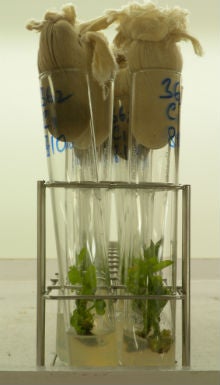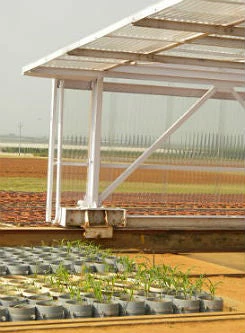 Deep inside the ICRISAT campus just outside Hyderabad, there are two sub-zero rooms that house the seeds of 120,000 plants from over 100 countries and 120,000 chances to change poor farmers' lives. The rows of plastic containers and freeze-dried metallic packages resemble a huge and very cold medicine cabinet.
Deep inside the ICRISAT campus just outside Hyderabad, there are two sub-zero rooms that house the seeds of 120,000 plants from over 100 countries and 120,000 chances to change poor farmers' lives. The rows of plastic containers and freeze-dried metallic packages resemble a huge and very cold medicine cabinet.
These seed banks, or genebanks, hold the keys to growing more productive, hardier, healthier food crops that could help feed the 9 billion people who will be living on Earth by 2050. Scientists use the collection to map characteristics that enable individual plants to withstand water shortages, pests, and disease, or increase yields and nutrient levels. Over 800 improved crop varieties have been developed from this seed bank and now grow in 79 countries.
ICRISAT is the international crop research institute for the semi-arid tropics and one of 15 CGIAR research centers. Scientist here work on sorghum, millet, chickpeas, pigeon peas, and ground nuts - the food crops that smallholder farmers from the driest parts of the world depend on for their survival.
A walk through the campus reveals the power and potential of international research.
Just one example among hundreds - a millet known as ictp83 was gathered in Togo and brought to India in 1983. Over the years, the millet has been improved until today it not only has twice the iron value of typical millet but is high yielding and hardy. In its new improved form, it is a big hit with local farmers in India and in Africa.
The fields reflect the huge crop variations that the plant breeders have developed over time. Sorghum grown for height, for high biomass, or for drought tolerance. Ground nuts grown for high iron or oil content or both or simply higher yields. Pigeon peas bred for yield and speed as the need to survive short and erratic growing seasons increases.

But the researchers here are testing integrated farming systems as well as individual plant characteristics. A watershed management approach combining food and nitrogen-fixing crops results in improved soil and water conservation and better yields and carbon sequestration. Trialed at the request of the Government of India in Karnataka, the system helped 3 million farmers increase their yields between 20 and 60 percent.
The ICRISAT campus medicine cabinet promises and delivers healthier, hardier food crops for poor farmers; climate-smart farming systems that increase incomes, yields, and capture carbon; sophisticated gene mapping; and everything in between.
As we face complex food and water crises, and climate change threatens to roll back the development gains of decades, the work of the ICRISAT scientist has never been more important. For anyone with a dollar to spend on reducing poverty, it’s a powerful investment.
Rachel Kyte
Vice President for Sustainable Development
www.worldbank.org/sustainabledevelopment
Twitter: @rkyte365


Join the Conversation